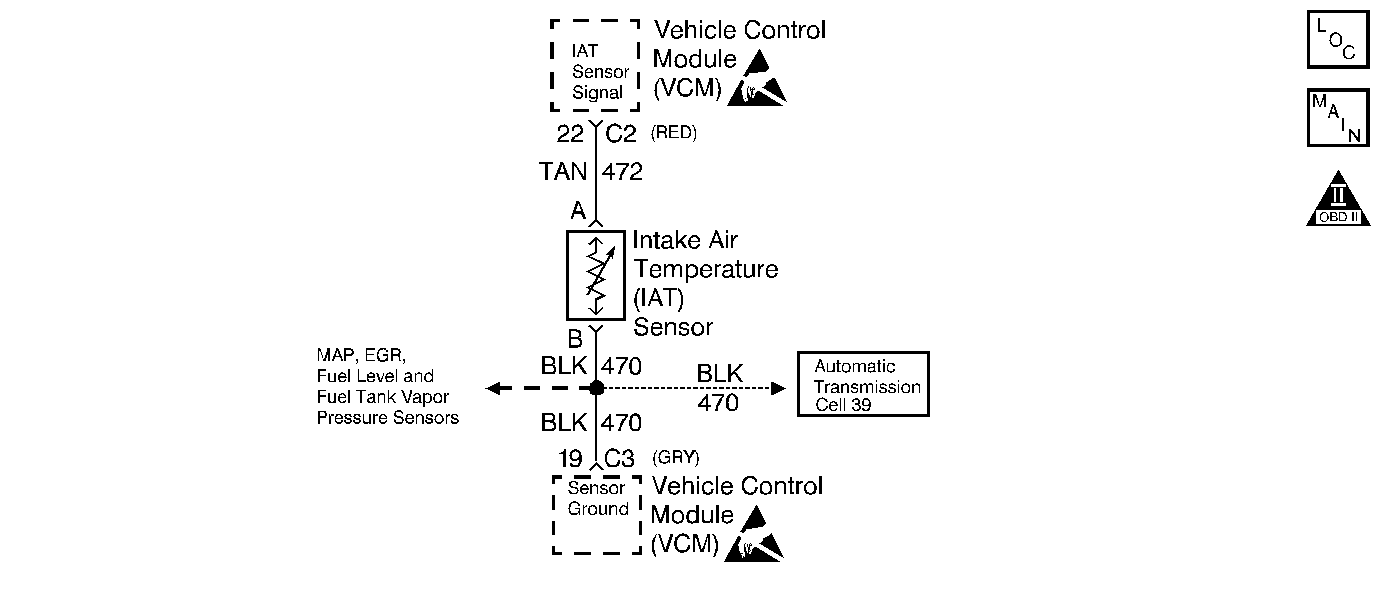
Circuit Description
The Intake Air Temperature (IAT) sensor is a thermistor located in the fresh air duct to the throttle body in order to monitor the temperature of the air entering the throttle body. The VCM applies 5 volts to the sensor on the 5 volt reference circuit. When the air is cool, the resistance in the sensor measures high and the VCM senses a high voltage signal. If the air is warm, the sensor resistance measures low and the VCM senses a low voltage signal. This DTC is a type A DTC.
Conditions for Setting the DTC
| • | No ECT sensor DTCs |
| • | No VS sensor DTCs |
| • | No MAF sensor DTCs |
| • | The vehicle speed less than 2 mph |
| • | The MAF is less than 250 grams per second |
| • | The engine coolant temperature greater than 84.7°C |
| • | The engine run time is greater than 100 seconds |
| • | The intake air temperature voltage greater than 4.9 volts |
Action Taken When the DTC Sets
The VCM turns the MIL ON when P0113 is reported and 1 failure has occurred.
Conditions for Clearing the MIL or DTC
| • | The control module turns OFF the MIL after 3 consecutive drive trips when the test has run and passed. |
| • | A history DTC will clear if no fault conditions have been detected for 40 warm-up cycles. A warm-up cycle occurs when the coolant temperature has risen 22°C (40°F) from the startup coolant temperature and the engine coolant reaches a temperature that is more than 70°C (158°F) during the same ignition cycle. |
| • | Use a scan tool in order to clear the DTCs. |
Diagnostic Aids
A scan tool indicates the temperature of the ambient air which is entering the throttle body. The air temperature should read very close to the temperature of the outside air. The air temperature should rise gradually as the engine warms up and the underhood temperature increases. If DTC P1111 is set, the problem is intermittent. Check for an open in the IAT sensor circuit. This may be accomplished by moving the VCM harness at various locations and monitoring IAT temperature or IAT voltage on the scan tool. If the voltage varies, look for an open in the area of the harness that caused the variance. Also, a sensor may become skewed or mis-scaled. The Temperature vs. Resistance Value Table will help in order to detect a skewed sensor. Refer to Temperature vs Resistance .
Test Description
The numbers below refer to the step numbers on the diagnostic table.
Important: Use the same diagnostic test equipment for all the measurements.
-
If the IAT sensor circuit voltage measures greater than 4.90 volts, the conditions for the DTC are still present, and the problem is not intermittent.
-
This test will bypass the IAT sensor and will confirm that the IAT signal circuit and the sensor ground circuit to the VCM are sound. Grounding the signal circuit will provide a low voltage input to the VCM. The VCM should recognize this low voltage and indicate a high IAT temperature.
-
This test determines if the IAT sensor signal circuit is okay. If the scan tool does not indicate a high temperature, the IAT signal circuit is open.
Step | Action | Value(s) | Yes | No |
|---|---|---|---|---|
1 |
Important: Before clearing the DTCs, use the scan tool in order to record the Freeze Frame and the Failure Records for reference. This data will be lost when the Clear DTC Information function is used. Was the Powertrain On-Board Diagnostic (OBD) System Check performed? | -- | ||
Is the IAT sensor voltage greater than the specified value? | 4.90 V | |||
Does the scan tool display an IAT sensor voltage less than the specified value? | 0.82 V | |||
Jumper the IAT sensor signal circuit to a known good ground. Does the scan tool display an IAT sensor voltage less than the specified value? | 0.82 V | |||
5 | Use a DVM J 39200 in order to check the voltage between the IAT sensor signal circuit and a known good ground. Is the voltage greater than the specified value? | 5.20 V | ||
6 | The DTC is intermittent. Are any additional DTCs stored? | -- | Go to The Applicable DTC Table | Go to Diagnostic Aids |
7 | Inspect the sensor connector and the VCM connector for the proper connection. Was a problem found? | -- | ||
8 | Check the IAT sensor ground circuit for an open between the IAT sensor and the VCM. Was a problem found? | -- | ||
9 | Check the sensor signal circuit for an open between the IAT sensor and the VCM. Was a problem found? | -- | ||
10 | Repair the short to voltage in the IAT sensor signal circuit. Refer to Wiring Repairs Electrical Diagnosis. Is the action complete? | -- | -- | |
11 | Repair the circuit as necessary. Refer to Wiring Repairs in Electrical Diagnosis. Is the action complete? | -- | -- | |
12 | Replace the IAT sensor. Refer to IAT Sensor Replacement . Is the action complete? | -- | -- | |
13 | Replace the VCM. Important: When replacing the VCM, the new VCM will need to be programmed. Refer to VCM Replacement/Programming . Is the action complete? | -- | -- | |
14 |
Does the scan tool indicate that this diagnostic ran and passed? | -- | ||
15 | Use the scan tool in order to display the Capture Info and the Review Capture Info functions. Are there any DTCs displayed that have not been diagnosed? | -- | Go to The Applicable DTC Table | System OK |
